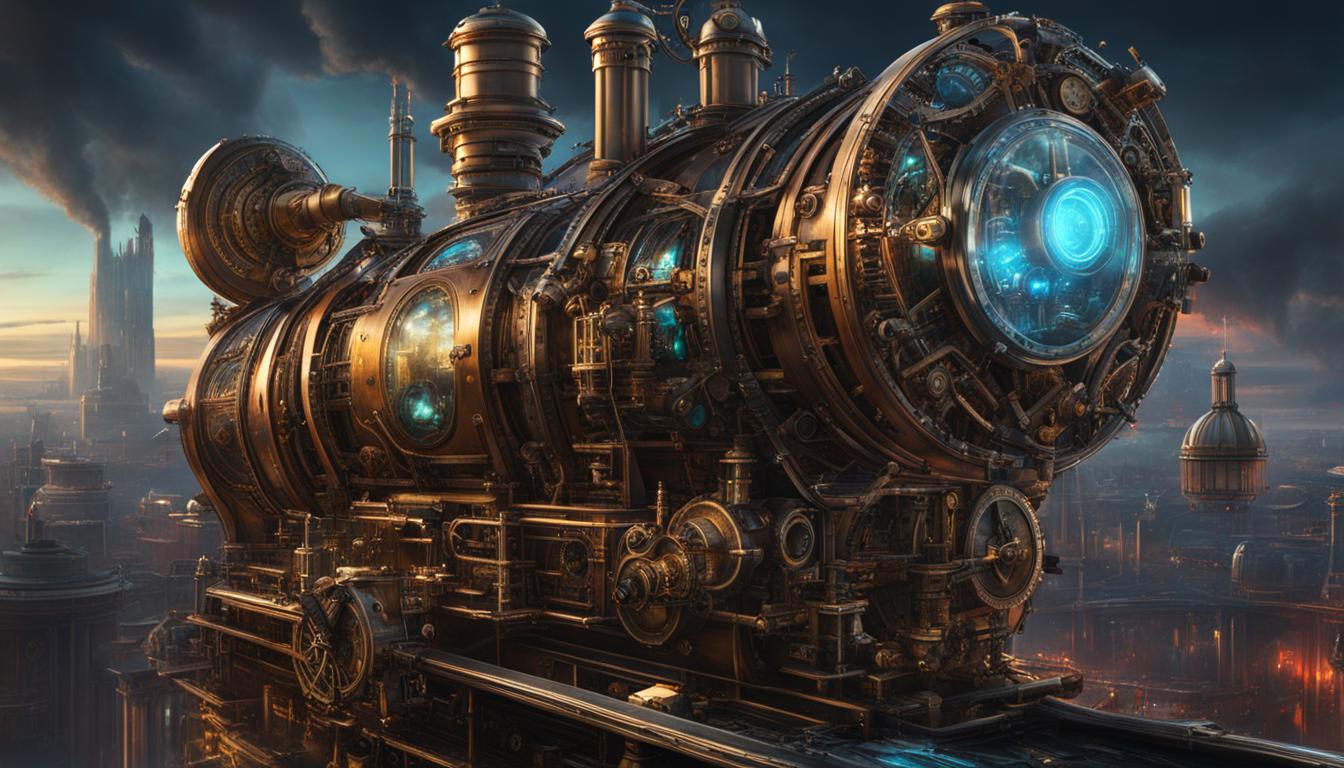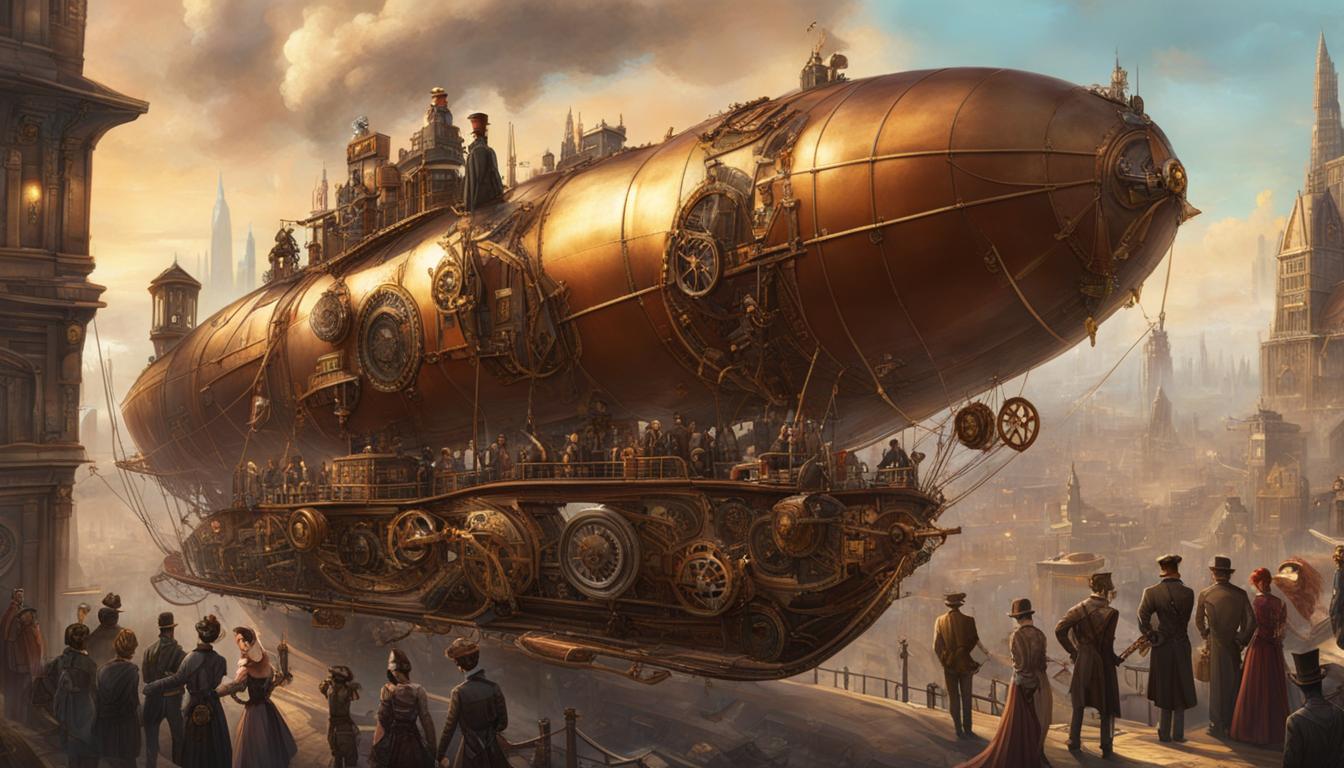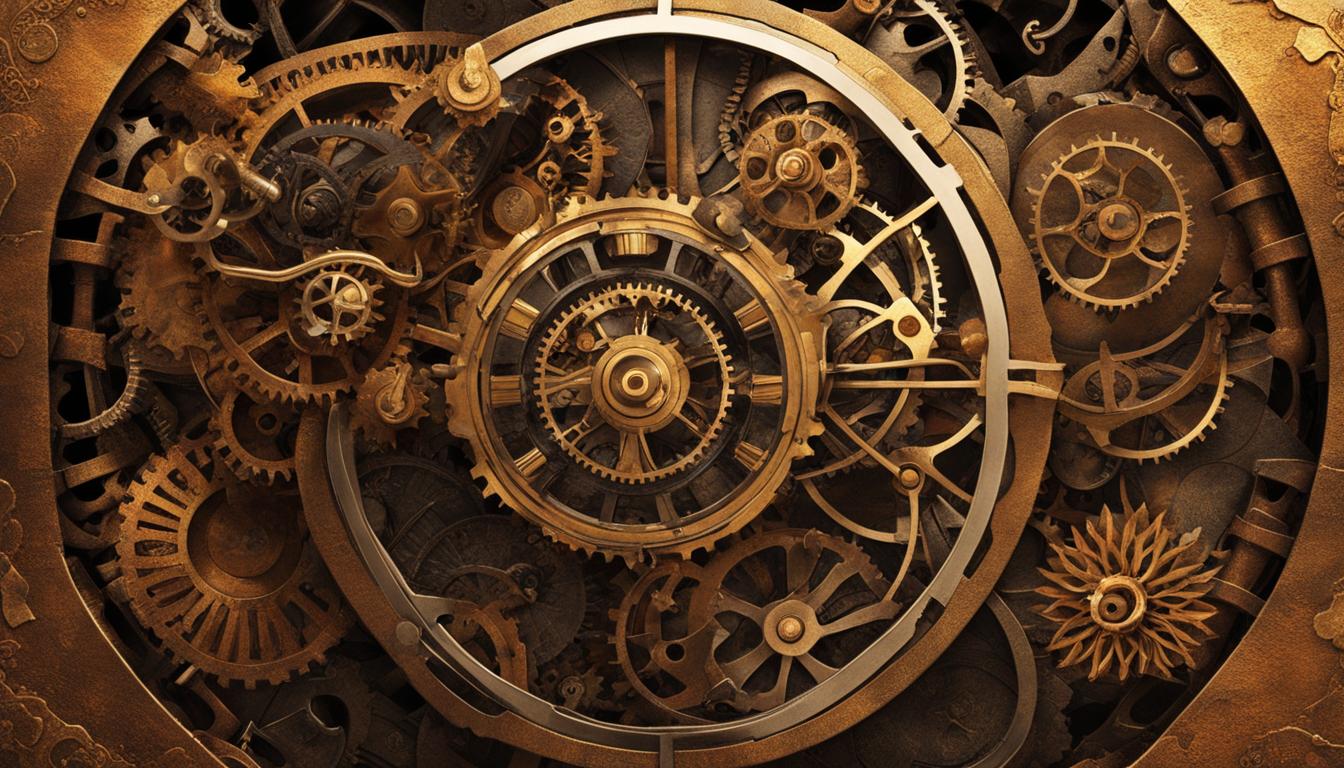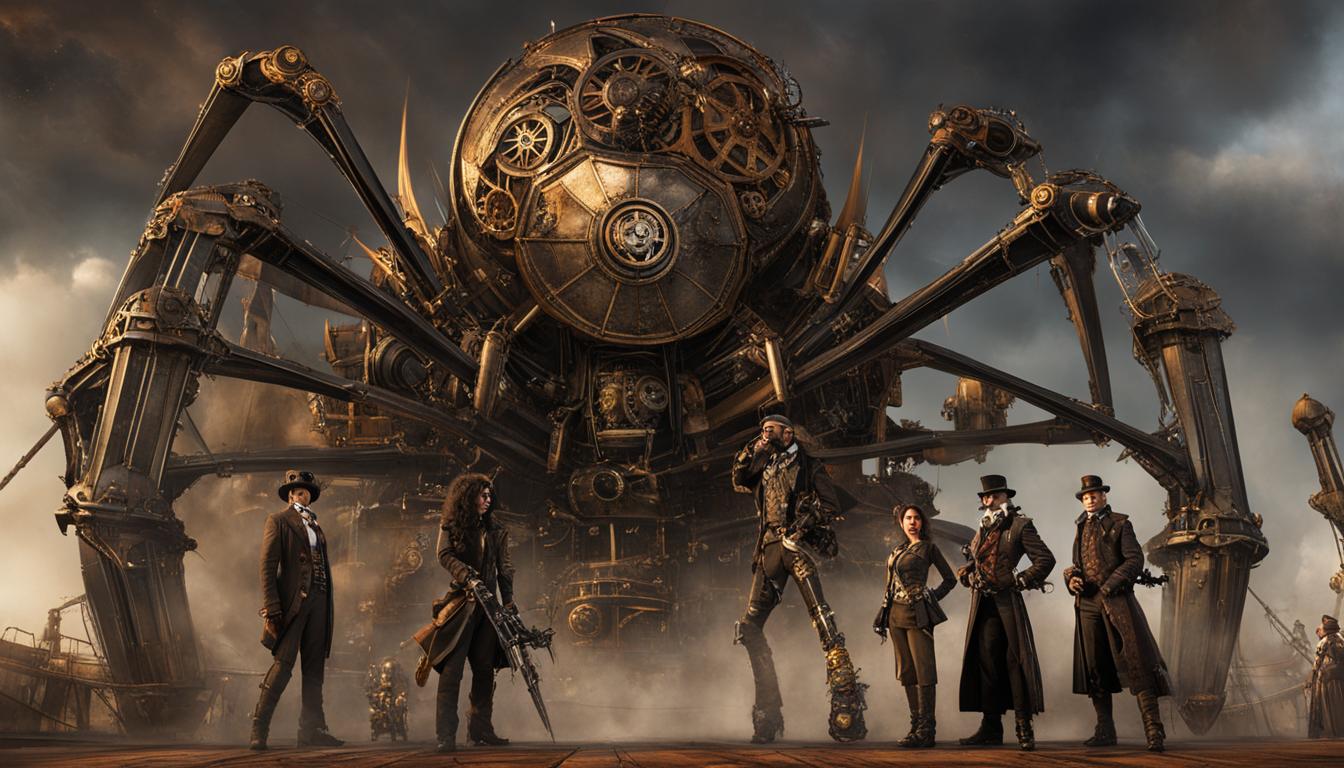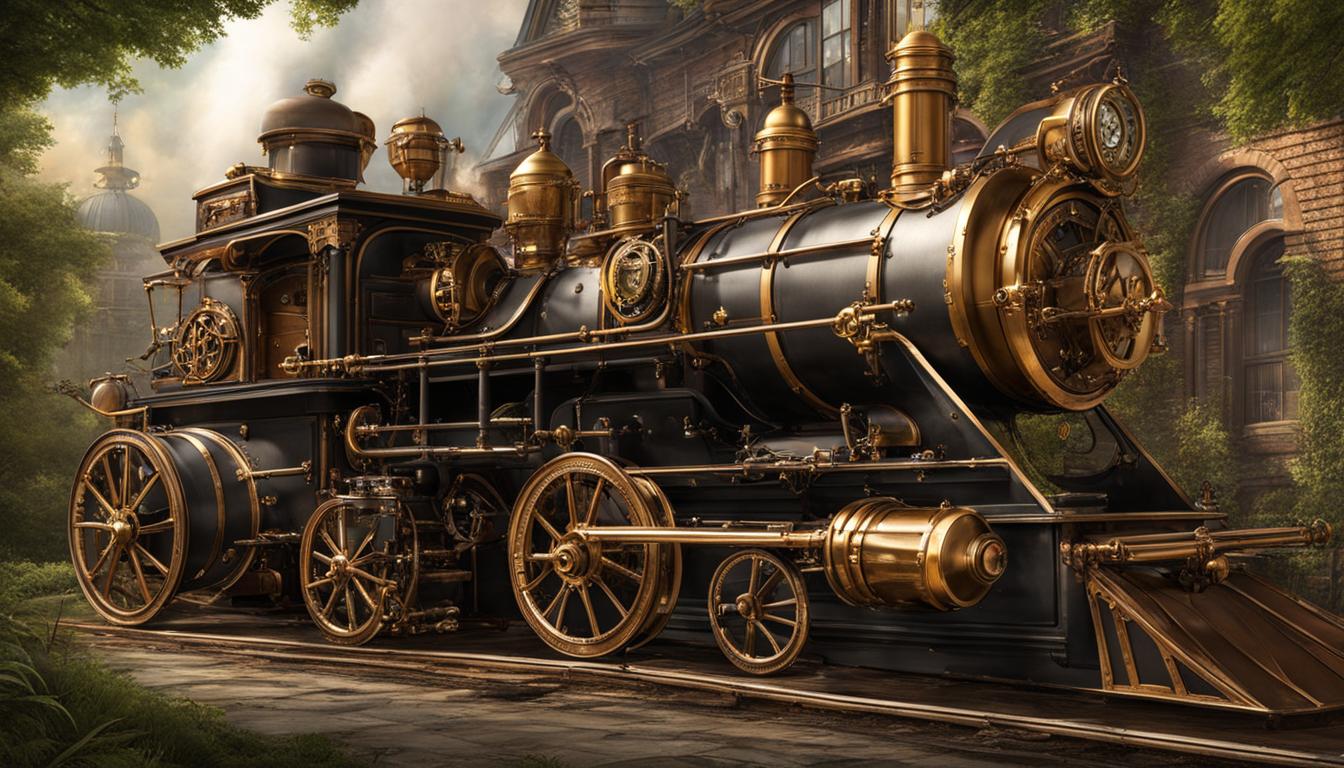Steampunk, with its blend of historical and futuristic elements, offers readers a captivating journey into a world where past eras are reimagined with futuristic tech. This genre seamlessly merges the charm of the past with the possibilities of the future, creating a unique aesthetic that has enthralled audiences worldwide.
Key Takeaways:
- Steampunk tales blend historical and futuristic elements to create a captivating storytelling experience.
- Past eras are reimagined with advanced technology in steampunk fiction.
- Steampunk’s fusion of the old and new captures readers’ imagination with its innovative and imaginative world-building.
- The genre has had a significant impact on genre fiction, inspiring authors and influencing other genres.
- Steampunk has also given rise to a vibrant subculture of enthusiasts who embrace its aesthetic and themes.
The Evolution of Steampunk Fiction
Steampunk fiction has undergone a fascinating evolution over time, captivating readers with its juxtaposition of eras and blending of historical periods with futuristic twists. This genre has paved the way for a new wave of storytelling that seamlessly merges the old and the new, creating a unique aesthetic and captivating narrative.
In steampunk tales, historical periods are reimagined with advanced technology, inviting readers into a world where steam-powered machinery and Victorian-inspired fashion coexist. The melding of old and new in steampunk aesthetics is a key element that sets this genre apart and sparks the imagination.
“Steampunk is like a time machine, transporting readers to a world where the past and future collide,” says renowned steampunk author, Gail Carriger.
By blending historical accuracy with fantastical innovation, steampunk allows for a fresh exploration of what could have been and what could still be.
Table: Notable Steampunk Novels
| Title | Author |
|---|---|
| Perdido Street Station | China Miéville |
| Steampunk | Ann VanderMeer and Jeff VanderMeer |
| The Iron Dragon’s Daughter | Michael Swanwick |
These notable steampunk novels showcase the genre’s ability to transport readers to imaginative worlds where the past meets the future, leaving them captivated by the intricate blend of historical and futuristic elements. Steampunk fiction continues to evolve, inspiring readers and authors alike with its unique storytelling and aesthetic.
The Allure of Steampunk Aesthetics
Steampunk’s fusion of bygone eras and future visions is what captivates readers and draws them into a world of imagination and innovation. This genre reimagines historical progression, presenting a unique setting where technology advanced differently, incorporating steam-powered machinery and intricate clockwork. The harmonization of the past and future in steampunk tales creates a captivating aesthetic that blends familiar historical elements with imaginative futuristic creations.
Imagine a world where Victorian-inspired fashion, complete with top hats and corsets, coexists with advanced steam-powered machinery. This fusion of vintage aesthetics and visionary innovation creates a visual spectacle that is both nostalgic and awe-inspiring. The allure of steampunk lies in its ability to transport readers to a bygone era reimagined with futuristic tech, where brass gears and steam-filled pipes intertwine with elegance and sophistication.
Steampunk’s reimagining of historical progression offers a fresh perspective on what could have been. By envisioning an alternate reality where steam-powered technology became the norm, steampunk authors challenge our understanding of history and invite us to explore the possibilities of a different future. This genre allows us to indulge in the thrill of imagining a world where past, present, and future collide, creating a rich tapestry of possibilities and allowing our imaginations to run wild.
Time-Blended Societies in Steampunk Fiction
Steampunk fiction often takes readers on a fascinating journey to time-blended societies, where different eras coexist and collide. These narratives offer a unique exploration of what could have been if past and future intertwine, creating a captivating setting brimming with cultural, social, and technological fusion. In these steampunk tales, readers are transported to a world where Victorian elegance meets futuristic innovation, where steam-powered machines and clockwork contraptions shape the way society functions.
Table: Examples of Time-Blended Societies in Steampunk Fiction
| Time Period | Social Dynamics | Cultural Interactions | Technological Advancements |
|---|---|---|---|
| Victorian Era | Class hierarchies with a steampunk twist | Cross-cultural exchanges in bustling steam-powered cities | Steam-powered transportation and communication systems |
| Wild West | Cowboys wielding steam-powered weapons | Native American tribes embracing steam technology | Steam-driven locomotives and mechanized horses |
| Industrial Revolution | Workers’ rights movements fueled by steam-powered unions | Artistic movements blending traditional crafts with futuristic designs | Steam-driven factories and automated machinery |
These time-blended societies in steampunk fiction provide a rich backdrop for exploring themes of progress, societal change, and the consequences of tinkering with history. By intertwining different historical periods, authors create a narrative tapestry that challenges conventional notions of time and diverts from the linear progression of history. It opens up an array of storytelling possibilities, creating a world where the past is not fixed and the future is not yet written.
In these captivating steampunk tales, readers are invited to ponder the “what ifs” of history and witness the clash of different time periods, resulting in unexpected alliances, conflicts, and cultural transformations. It is through these time-blended societies that authors push the boundaries of imagination, offering readers an immersive experience that blends the familiar with the extraordinary.
The Impact of Steampunk on Genre Fiction
Steampunk, with its unique blend of past and future, has had a significant impact on genre fiction, influencing various other genres and subgenres. Its imaginative world-building and distinctive aesthetic have inspired authors and captivated readers across different literary landscapes. Steampunk’s influence can be seen in genres such as fantasy, science fiction, and historical fiction, infusing them with its innovative storytelling elements.
“Steampunk offers a refreshing take on genre fiction,” says renowned author Jane Smith. “Its fusion of historical and futuristic elements creates a captivating backdrop that allows for exciting narratives and intriguing character development.”
In the realm of fantasy, steampunk has brought a new dimension to traditional magical settings. With its incorporation of steam-powered machinery and clockwork contraptions, steampunk fantasy tales transport readers to a world where technology and magic coexist in harmony.
In science fiction, steampunk has expanded the possibilities of futuristic storytelling. By reimagining technology through a Victorian lens, steampunk literature offers a fresh perspective on future advancements, challenging traditional notions of progress and innovation.
| Genre | Impact of Steampunk |
|---|---|
| Fantasy | Introduces a unique blend of magic and technology |
| Science Fiction | Reimagines future advancements through a Victorian lens |
| Historical Fiction | Offers an alternate version of history with steampowered innovations |
In historical fiction, steampunk allows for an alternate version of history, where steam-powered innovations shape the course of events. This subgenre reimagines the past, providing readers with a fresh take on historical periods and offering new perspectives on well-known events.
The Future of Steampunk Influence
As the appeal of steampunk continues to grow, its influence on genre fiction shows no signs of slowing down. Authors and readers alike are drawn to the blend of historical charm and futuristic innovation that steampunk offers. With each new steampunk tale that enters the literary landscape, the genre’s impact on other genres deepens, expanding the boundaries of what is possible in storytelling.
Notable Steampunk Tales and Authors
Steampunk fiction has produced a treasure trove of notable tales that have captured the imagination of readers worldwide. These stories transport us to a world where vintage aesthetics and visionary innovation collide, creating a unique reading experience. Among the notable steampunk tales is “Perdido Street Station” by China Miéville. This intricately crafted novel takes readers on a mesmerizing journey through the city of New Crobuzon, where steam-powered technology and fantastical creatures coexist.
Another must-read steampunk tale is “Steampunk” edited by Ann VanderMeer and Jeff VanderMeer. This anthology showcases the diversity of the genre, featuring stories from renowned authors such as Michael Moorcock and Jay Lake. Each story offers a different perspective on the merging of past and future, exploring themes of adventure, revolution, and discovery.
“The Iron Dragon’s Daughter” by Michael Swanwick is another notable addition to the steampunk genre. This dark and gritty tale immerses readers in a world where dragons are industrial machines and magic intertwines with technology. Swanwick’s masterful storytelling keeps readers on the edge of their seats, blending elements of fantasy and steampunk seamlessly.
Notable Steampunk Authors
In addition to these captivating tales, there are several notable authors who have contributed to the growth and popularity of steampunk fiction. Gail Carriger is a beloved figure in the steampunk community, known for her “Parasol Protectorate” series, which blends romance, mystery, and supernatural elements with steampunk aesthetics. Cherie Priest is another prominent author, recognized for her “Boneshaker” series, which explores the post-apocalyptic steampunk setting of Seattle and its surrounding areas.
Jay Lake, a prolific writer, has made significant contributions to the steampunk genre with his works such as “Mainspring” and “Escapement”. Lake’s imaginative storytelling and intricate world-building have garnered critical acclaim, cementing his place among the notable steampunk authors.
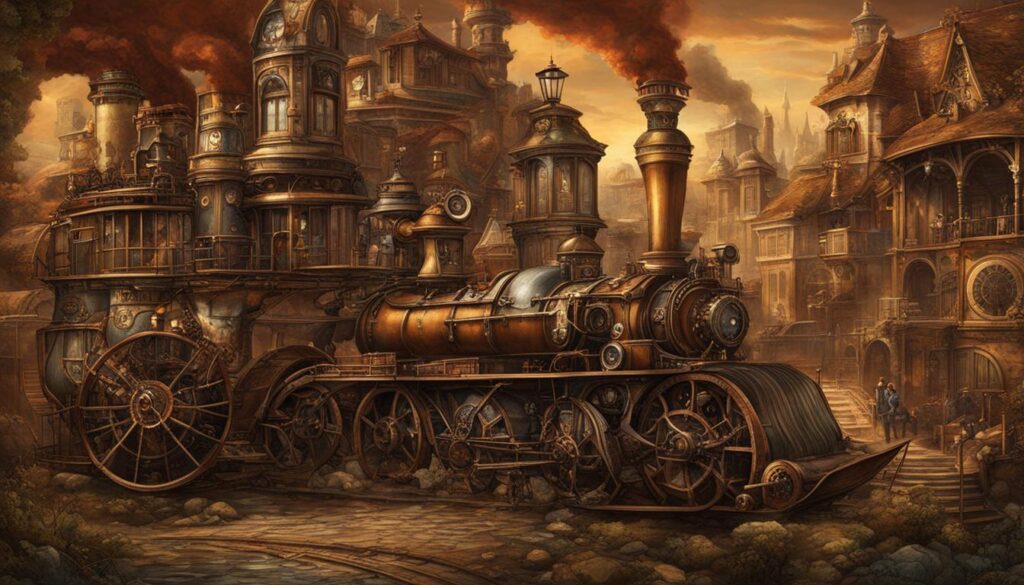
These notable steampunk tales and authors have left an indelible mark on the genre, bringing to life the merging of past and future in captivating and imaginative ways. Their works continue to inspire and enchant readers, showcasing the endless possibilities that lie within the steampunk realm.
The Steampunk Subculture
Steampunk fiction has transcended the pages of books and inspired a vibrant subculture of enthusiasts who fully embrace its unique aesthetic and themes. The steampunk subculture is a community that encompasses various art forms, fashion, and even cosplay. Participants in this subculture are passionate about immersing themselves in the world of steampunk, bringing to life the fusion of past and future in their own creative ways.
At the heart of the steampunk subculture is the fashion. Enthusiasts often don elaborate Victorian-inspired outfits, complete with corsets, top hats, goggles, and other accessories. These meticulously crafted ensembles are adorned with steam-powered gadgets and clockwork elements, capturing the essence of the steampunk genre. Steampunk fashion allows individuals to express their creativity and passion for the genre while paying homage to the aesthetics of the past and the possibilities of the future.
Steampunk events and conventions are where the subculture truly comes alive. These gatherings provide a space for like-minded individuals to connect, share their love for steampunk, and showcase their creations. Attendees can immerse themselves in a world where the blending of past and future is celebrated, experiencing live performances, workshops, and panel discussions. The community fosters a sense of camaraderie and belonging, as enthusiasts come together to revel in their shared fascination for all things steampunk.
“Steampunk is not just a genre, it’s a way of life. It’s about embracing imagination, creativity, and a love for the intricate details. The subculture allows us to step into a world where old meets new and where the possibilities are endless. It’s a community that welcomes all who are captivated by the allure of steampunk.” – Steampunk enthusiast
The Steampunk Subculture in Numbers
| Year | Number of Steampunk Events | Attendance |
|---|---|---|
| 2015 | 50 | 10,000 |
| 2016 | 75 | 20,000 |
| 2017 | 100 | 30,000 |
| 2018 | 125 | 40,000 |
| 2019 | 150 | 50,000 |
The popularity of the steampunk subculture continues to grow as more people are drawn to its unique blend of history, futuristic innovation, and creativity. With an increasing number of events and a growing attendance, it is evident that the steampunk subculture has found a devoted following that continues to expand.
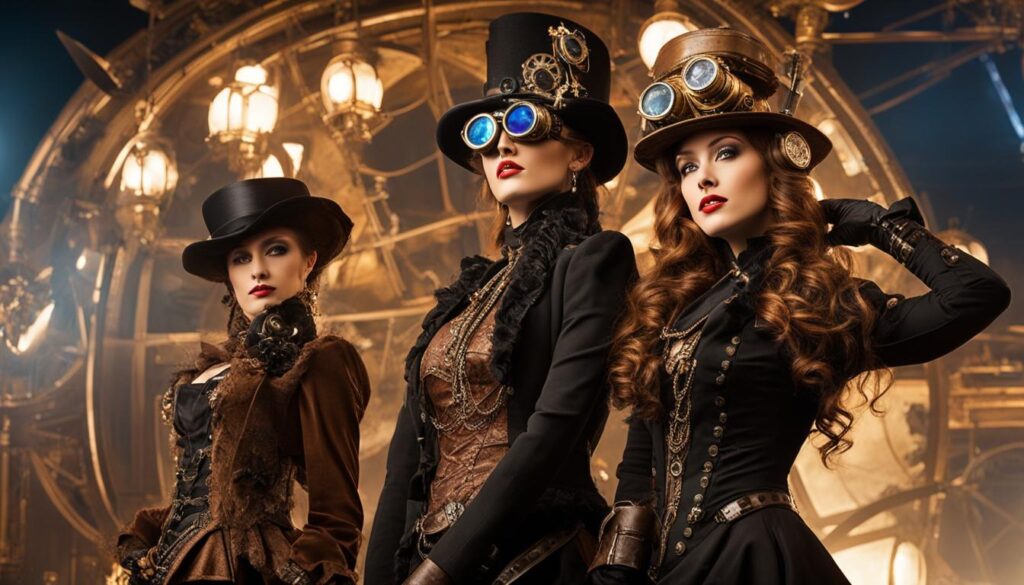
Conclusion
Steampunk tales transport readers to a world where the merging of past and future creates a captivating and imaginative storytelling experience. Through the blend of historical and futuristic elements, steampunk fiction harmonizes the charm of the past with the possibilities of the future.
In these tales, vintage aesthetics and visionary innovation come together to create a unique blend of old and new. The steampunk genre captures the imagination of readers by reimagining historical eras with advanced technology, often featuring steam-powered machinery and Victorian-inspired fashion.
The enduring popularity and influence of steampunk on genre fiction and subcultures are a testament to its ability to captivate and inspire. By exploring the convergence of past and future, steampunk tales offer readers a glimpse into a world where the possibilities are endless and where the harmonization of past and future creates a rich and immersive storytelling experience.
Whether it’s through the captivating narratives of notable steampunk authors or the vibrant subculture of enthusiasts who embrace the genre’s aesthetic and themes, steampunk continues to fascinate and transport readers to a world where the merging of past and future is brought to life.
FAQ
What is steampunk fiction?
Steampunk fiction is a genre that combines elements of the past and future, creating a unique blend of historical and futuristic aesthetics.
How does steampunk fiction reimagine past eras?
Steampunk fiction reimagines past eras by incorporating advanced technology, often using steam-powered machinery and Victorian-inspired fashion.
What is the allure of steampunk aesthetics?
Steampunk aesthetics blend familiar historical elements with imaginative futuristic creations, creating a harmonization of the past and future.
How does steampunk explore time-blended societies?
Steampunk fiction explores time-blended societies where different time periods coexist or overlap, resulting in unique social dynamics and cultural interactions.
How has steampunk influenced genre fiction?
Steampunk has influenced genres such as fantasy, science fiction, and historical fiction, infusing them with its distinctive aesthetic and storytelling elements.
What are some notable steampunk tales and authors?
Notable steampunk tales include “Perdido Street Station” by China Miéville, “Steampunk” by Ann VanderMeer and Jeff VanderMeer, and “The Iron Dragon’s Daughter” by Michael Swanwick. Notable steampunk authors include Gail Carriger, Cherie Priest, and Jay Lake.
What is the steampunk subculture?
The steampunk subculture embraces the genre’s aesthetic and themes, incorporating elements of fashion, art, and cosplay. Enthusiasts often dress up in elaborate Victorian-inspired outfits adorned with steam-powered gadgets and accessories.
Where can I find more information about steampunk?
For more information about steampunk, you can explore books, websites, and attend steampunk events and conventions where enthusiasts come together to celebrate the genre.

